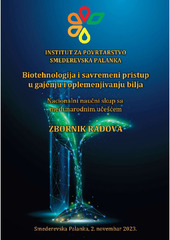Приказ основних података о документу
Prinos zrna različitih genotipova kukuruza u zavisnosti od primene cinka
Grain yield of different corn genotypes depending on zink application
| dc.creator | Stepić, Vesna | |
| dc.creator | Stepić, Vladimir | |
| dc.creator | Cvijanović, Gorica | |
| dc.creator | Bajagić, Marija | |
| dc.creator | Zečević, Veselinka | |
| dc.creator | Đurić, Nenad | |
| dc.date.accessioned | 2023-10-26T07:39:05Z | |
| dc.date.available | 2023-10-26T07:39:05Z | |
| dc.date.issued | 2023 | |
| dc.identifier.isbn | 978-86-89177-06-0 | |
| dc.identifier.uri | http://RIVeC.institut-palanka.rs/handle/123456789/742 | |
| dc.description.abstract | Kukuruz, kao visokoprinosna biljka velike vegetativne mase i dugog vegetacionog perioda, ima velike potrebe u pogledu ishrane i navodnjavanja. Pored makroelemenata koji su nosioci prinosa, u ishrani biljaka veliki značaj imaju i mikroelementi, među kojima se ističe cink. Cilj ovog rada je određivanje uticaja cinka na visinu prinosa zrna različitih genotipova kukuruza. Trofaktorijalan ogled je postavljenu u regionu Posavo-tamnave u periodu od 2017. do 2018. godine. U proseku za 2018., najveći uticaj na visinu prinosa zrna imala je količina od 120 kg N ha-1 (7,86 t ha-1). Pri ovom đubrenju, hibridi ZP 427 (8,17 t ha-1) i ZP 548 (8,02 t ha-1) imali su najveći prinos zrna. Hibrid ZP 684 pri količini od 160 kg N ha-1 imao je najveći prinos zrna (7,81 t ha-1). Tretmani su različito delovali na prinos zrna kod hibrida. U odnosu na kontrolu T1, tretman T2 je za 14,56% povećao prinos, a T3 za 14,17%. | sr |
| dc.description.abstract | Maize, as a high-yielding plant with a large vegetative mass and a long growing season, has great needs in terms of nutrition and irrigation. In addition to macro elements which are the fundamental for yield, microelements are also of the great importance in corn nutrition, among which zinc stands out. The aim of the work was to determine the influence of zinc on the grain yield of different maize genotypes. A three-factorial experimental trial was set up in the Posavo-tamnava region in the period from 2017-2018. On average for 2018, the amount of 120 kg N ha-1 had the greatest impact on grain yield (7.86 t ha-1). With this fertilization, hybrids ZP 427 (8.17 t ha-1) and ZP 548 (8.02 t ha-1) had the highest grain yield. The hybrid ZP 684 at the amount of 160 kg N ha-1 had the highest grain yield (7.81 t ha-1). Treatments had different effects on grain yield in hybrids. Compared to control T1, treatment T2 increased yield by 14.56%, and T3 by 14.17%. | sr |
| dc.language.iso | sr | sr |
| dc.publisher | Smederevska Palanka : Institut za povrtarstvo | sr |
| dc.relation | info:eu-repo/grantAgreement/MESTD/inst-2020/200216/RS// | sr |
| dc.rights | openAccess | sr |
| dc.rights.uri | https://creativecommons.org/licenses/by/4.0/ | |
| dc.source | Zbornik radova : Nacionalni naučni skup sa međunarodnim učešćem Biotehnologija i savremeni pristup u gajenju i oplemenjivanju bilja, Smederevska Palanka 2. novembar | sr |
| dc.subject | kukuruz | sr |
| dc.subject | količina azota | sr |
| dc.subject | cink | sr |
| dc.subject | prinos zrna | sr |
| dc.subject | maize | sr |
| dc.subject | nitrogen amount | sr |
| dc.subject | zinc | sr |
| dc.subject | grain yield | sr |
| dc.title | Prinos zrna različitih genotipova kukuruza u zavisnosti od primene cinka | sr |
| dc.title | Grain yield of different corn genotypes depending on zink application | sr |
| dc.type | conferenceObject | sr |
| dc.rights.license | BY | sr |
| dc.citation.epage | 215 | |
| dc.citation.spage | 206 | |
| dc.identifier.fulltext | http://RIVeC.institut-palanka.rs/bitstream/id/2387/bitstream_2387.pdf | |
| dc.identifier.rcub | https://hdl.handle.net/21.15107/rcub_rivec_742 | |
| dc.type.version | publishedVersion | sr |


